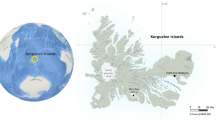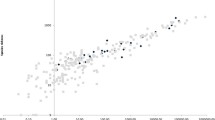Abstract
The biodiversity in the sub-Antarctic region is threatened by climatic change and biological invasions, which makes the understanding of distributions of biotas on sub-Antarctic islands essential. Although the distribution patterns of vascular plants and insects on sub-Antarctic islands are well documented, this is not always the case for microarthropods. This study provides the first quantitative assessment of the distribution and abundance of microarthropods on Prince Edward Island (PEI), one of two islands in the Prince Edward Island group. Microarthropod community structure differed significantly between PEI and nearby Marion Island, with only two invasive alien species found on PEI compared with Marion Island. Furthermore, species richness, abundance and community structure differed significantly between habitat types on both islands. This study emphasizes the importance of quarantine measures when visiting PEI to maintain its status as one of the more pristine islands in the sub-Antarctic region.


Similar content being viewed by others
References
Anonymous (1996) Prince Edward Islands management plan. Department of environmental affairs and tourism, Pretoria
Barendse J, Chown SL (2001) Abundance and seasonality of mid-altitude fellfield arthropods from Marion Island. Polar Biol 24:73–82
Barendse J, Mercer RD, Marshall DJ, Chown SL (2002) Habitat specificity of mites on sub-Antarctic Marion Island. Environ Entomol 31:612–625
Bellido A, Cancela da Fonseca JP (1988) Spatio-temporal organization of the oribatid mite community in a littoral turf of the Kerguelen archipelago. Pedobiologia 31:239–246
Bergström D, Chown SL (1999) Life at the front: history, ecology and change on southern ocean islands. Trends Ecol Evol 14:472–477
Bergström D, Selkirk P (1997) Distribution of bryophytes on subantarctic Heard Island. The Bryologist 100:349–355
Bergström D, Turner PAM, Scott J, Copson G, Shaw J (2005) Restricted plant species on sub-Antarctic Macquarie and Heard islands. Polar Biol DOI: 10.1007/s00300-005-0085-2
Burger AE (1978) Terrestrial invertebrates: a food resource for birds at Marion Island. S Afr J Antarct Res 8:87–99
Cassey P, Blackburn TM, Duncan RP, Chown SL (2005) Concerning invasive species: Reply to Brown and Sax. Austral Ecol 30:475–480
Chapuis JL, Boussès P, Barnaud G (1994) Alien mammals, impact and management in the French Subantarctic islands. Biol Conserv 67:97–104
Chown SL (1992) A preliminary analysis of weevil assemblages in the Sub-Antarctic: local and regional patterns. J Biogeogr 19:87–98
Chown SL, Gremmen NJM, Gaston KJ (1998) Ecological biogeography of southern ocean islands: Species-area relationships, human impacts, and conservation. Am Nat 152:562–575
Chown SL, Hull B, Gaston KJ (2005) Human impacts, energy availability and invasion across Southern Ocean islands. Global Ecol Biogeogr 14:521–528
Chown SL, Klok CJ (2001) Habitat use, diet and body size of Heard Island weevils. Polar Biol 24:706–712
Chown SL, McGeoch MA, Marshall DJ (2002) Diversity and conservation of invertebrates on the sub-Antarctic Prince Edward Islands. Afr Entomol 10:67–82
Chown SL, Rodrigues AS, Gremmen NJM, Gaston KJ (2001) World heritage status and the conservation of Southern Ocean islands. Conserv Biol 15:550–557
Christiansen K, Bellinger P (1995) The biogeography of Collembola. Polskie Pismo Entomologiczne
Clarke KR, Gorley RN (2001) PRIMER v5: User manual/tutorial. PRIMER-E Ltd, Plymouth
Clarke KR, Warwick RM (1994) Change in marine communities: an approach to statistical analysis and interpretation. Plymouth Marine Laboratory, Plymouth
Convey P, Greenslade P, Arnold RJ, Block W (1999) Collembola of sub-Antarctic South Georgia. Polar Biol 22:1–6
Cooper J, Condy PR (1988) Environmental conservation at the sub-Antarctic Prince Edward Islands: a review and recommendations. Environ Conserv 15:317–326
Crafford JE, Scholtz CH (1987) Quantitative differences between the insect faunas of sub-Antarctic Marion and Prince Edward Islands: a result of human intervention? Biol Conserv 40:255–262
Crafford JE, Scholtz CH, Chown SL (1986) The insects of sub-Antarctic Marion and Prince Edward Islands; with a bibliography of entomology of the Kerguelen Biogeographical Province. S Afr J Antarct Res 16:42–84
Delettre YR, Frenot Y, Vernon P, Chown SL (2003) First record of Telmatogeton sp. (Diptera: Chironomidae) at Heard Island. Polar Biol 26:423–426
Dobson AJ (2002) An introduction to generalized linear models. 2nd edition. Chapman & Hall/CRC Texts in Statistical Science, Boca Raton
Dreux P, Frenot Y, Jouventin P, Massé L, Verdier O (1988) First scientific expedition to I’le des Pingouins, Archipel Crozet. Polar Rec 24:235–238
Ernsting G, Brandjes GJ, Block W, Isaaks JA (1999) Life-history consequences of predation for a subantarctic beetle: evaluating the contribution of direct and indirect effects. J Anim Ecol 68:741–752
Frenot Y, Chown SL, Whinam J, Selkirk PM, Convey P, Skotnicki M, Bergstrom DM (2005) Biological invasions in the Antarctic: extent, impacts and implications. Biol Rev 80:45–72
Frenot Y, Gloaguen JC, Masse L, Lebouvier M (2001) Human activities, ecosystem disturbance and plant invasions in subantarctic Crozet, Kerguelen and Amsterdam Islands. Biol Conserv 101:33–50
Gabriel AGA, Chown SL, Barendse J, Marshall DJ, Mercer RD, Pugh PJA, Smith VR (2001) Biological invasions on Southern Ocean islands: the Collembola of Marion Island as a test of generalities. Ecography 24:421–430
Gaston KJ (2003) The Structure and Dynamics of Geographic Ranges. Oxford University Press, Oxford
Gewin V (2005) Eco-defense against invasions. PLoS Biol 3:2066–2071
Greenslade P (2002) Assessing the risk of exotic Collembola invading subantarctic islands: prioritising quarantine management. Pedobiologia 46:338–344
Gremmen NJM (1981) The vegetation of the Subantarctic islands Marion and Prince Edward. Dr. W. Junk The Hague
Gremmen NJM, Smith VR (1999) New records of alien vascular plants from Marion and Prince Edward Islands, sub-Antarctic. Polar Biol 21:401–409
Greve M, Gremmen NJM, Gaston KJ, Chown SL (2005) Nestedness of South Ocean island biotas: ecological perspectives on a biogeographical conundrum. J Biogeogr 32:155–168
Hall K (2002) Review of present and quaternary periglacial processes and landforms of the maritime and sub-Antarctic region. S Afr J Sci 98:71–81
Hänel C, Chown SL (1998) An Introductory Guide to the Marion and Prince Edward Island Special Nature Reserves. Department of Environmental Affairs and Tourism Pretoria
Hanski I (1999) Habitat connectivity, habitat continuity, and metapopulations in dynamic landscapes. Oikos 87:209–219
Hill JK, Thomas CD, Huntley B (1999) Climate and habitat availability determine 20th century changes in a butterfly’s range margin. Proc R Soc Lond B Biol Sci 266:1197–1206
Hughes JMR (1987) The distribution and composition of vascular plant communities on Heard Island. Polar Biol 7:153–162
Hugo EA, McGeoch MA, Marshall DJ (2004) Fine scale variation in microarthropod communities inhabiting the keystone species Azorella selago on Marion Island. Polar Biol 27:466–473
Le Roux PC, McGeoch MA (2004) The use of size as an estimator of age in the sub-Antarctic cushion plant, Azorella selago (Apiaceae). Arct Antarct Alp Res 36:608–616
Le Roux PC, McGeoch MA, Nyakatya MJ, Chown SL (2005) Effects of a short-term climate change experiment on a keystone plant species in the sub-Antarctic. Global Change Biol 11:1628–1639
Mack RN, Simberloff D, Lonsdale WM, Evans H, Clout M, Bazzaz FA (2000) Biotic invasions: causes, epidemiology, global consequences, and control. Ecol Appl 10:689–710
Marshall DJ, Chown SL (2002) The acarine fauna of Heard Island. Polar Biol 25:688–695
Marshall DJ, Gremmen NJM, Coetzee L, O’Connor BM, Pugh PJA, Theron PD, Uekermann EA (1999) New records of Acari from the sub-Antarctic Prince Edward Islands. Polar Biol 21:84–89
McCullagh P, Nelder JA (1998) Generalized Linear Models. Chapman and Hall/CRC, Florida
McGeoch MA et al (2006) Species and community responses to short-term climate manipulation: microarthropods in the sub-Antarctic. Austral Ecol (in press)
Parmesan C et al (1999) Poleward shifts in geographical ranges of butterfly species associated with regional warming. Nature 399:579–583
Prendini L (2005) Comment on “Identifying spiders through DNA barcodes”. Can J Zool 83:498–504
Pugh PJA (1993) A synonymic catalogue of the Acari from Antarctica, the sub-Antarctic Islands and the Southern Ocean. J Nat Hist 27:323–421
Pugh PJA (1994) The non-indigenous Acari of Antarctica and the sub-Antarctic islands. Zool J Linn Soc 110:207–217
Pugh PJA (2004) Biogeography of spiders (Araneae: Arachnida) on the islands of the Southern Ocean. J Nat Hist 38:1461–1487
Pugh PJA, Barsch I (1993) Ecology of the littoral Halacaridae (Acari: Prostigmata) of South Georgia in the sub-Antarctic. J Nat Hist 28:75–85
Pugh PJA, Dartnall HJG, McInnes SJ (2002) The non-marine Crustacea of Antarctica and the islands of the Southern Ocean: biodiversity and biogeography. J Nat Hist 36:1047–1103
Pugh PJA, Scott B (2002) Biodiversity and biogeography of non-marine Mollusca on the islands of the Southern Ocean. J Nat Hist 36:927–952
Quinn GP, Keough MJ (2002) Experimental design and data analysis for biologists. Cambridge University Press, Cambridge
Root TL, Price JT, Hall KR, Schneider SH, Rosenzweig C, Pounds JA (2003) Fingerprints of global warming on wild animals and plants. Nature 421:57–60
Samways MJ (1994) Insect conservation biology. Chapman and Hall, London
Scott JJ (1990) Changes in vegetation on Heard Island 1947–1987. In: Kerry KR, Hempel G (eds) Antarctic Ecosystems. Ecological change and conservation, vol repr. Springer, Berlin Heidelberg New York, pp 61–76
Shaw JD, Hovenden MJ, Bergstrom DM (2005) The impact of introduced ship rats (Rattus rattus) on seedling recruitment and distribution of a subantarctic megaherb (Pleurophyllum hookeri). Austral Ecol 30:118–125
Slabber S, Chown SL (2002) The first record of a terrestrial crustacean, Porcellio scaber (Isopoda, Porcellionidae), from sub-Antarctic Marion Island. Polar Biol 25:855–858
Smith VR (1987) The environment and biota of Marion Island. S Afr J Sci 83:211–220
Smith VR (2002) Climate change in the sub-Antarctic: An illustration from Marion Island. Clim Change 52:345–357
Smith VR, Steenkamp HE (2001) Classification of the terrestrial habitats on Marion Island based on vegetation and soil chemistry. J Veg Sci 12:181–198
Smith VR, Steenkamp M, French DD (1993) Soil decomposition potential in relation to environmental factors on Marion Island (Aub-Antarctic). Soil Biol Biochem 25:1619–1633
Smith VR, Steenkamp M, Gremmen NJM (2001) Terrestrial habitats on sub-Antarctic Marion Island: their vegetation, edaphic attributes, distribution and response to climate change. S Afr J Bot 67:641–654
Southwood TRE (1978) Ecological methods with particular reference to the study of insect populations. 2nd edn. Chapman and Hall, London
Turner PAM, Scott JJ, Rozefelds AC (2006) Probable long distance dispersal of Leptinella plumosa Hook.f. to Heard Island habitat status and discussion of its arrival. Polar Biol 29:160–168
Vogel M (1985) The distribution and ecology of epigeic invertebrates on the sub-Antarctic Island of South Georgia. Spixiana 8:153–163
Walther G-R, et al. (2002) Ecological responses to recent climate change. Nature 416:389–395
Whinam J, Chilcott N, Bergstrom DM (2005) Subantarctic hitchhikers: expeditioners as vectors for the introduction of alien oragnisms. Biol Conserv 121:207–219
Will KW, Rubinoff D (2004) Myth of the molecule: DNA barcodes for species cannot replace morphology for identification and classification. Cladistics 20:47–55
Acknowledgments
We thank Alvan Gabriel and Jaco Barendse for assistance with sampling, and David Marshall for advice on mite identifications. This work was partially supported by a South African National Antarctic Programme Grant to B. Jansen van Vuuren (GUN 2069543).
Author information
Authors and Affiliations
Corresponding author
Appendix
Rights and permissions
About this article
Cite this article
Hugo, E.A., Chown, S.L. & McGeoch, M.A. The microarthropods of sub-Antarctic Prince Edward Island: a quantitative assessment. Polar Biol 30, 109–119 (2006). https://doi.org/10.1007/s00300-006-0166-x
Received:
Revised:
Accepted:
Published:
Issue Date:
DOI: https://doi.org/10.1007/s00300-006-0166-x




